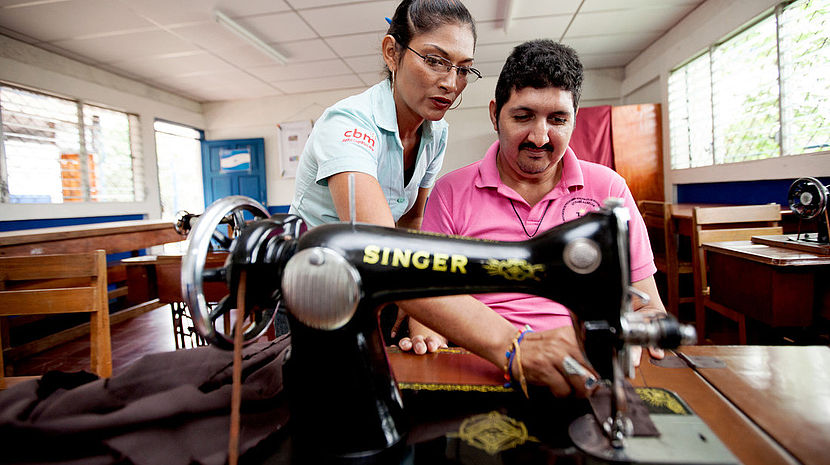Haiti - five years on

12 January 2015 marks the 5th anniversary of the earthquake in Haiti, which devastated the country in 2010, killing more than 200,000 people*, rendering a further 2.3 million homeless and displacing over 1.5 million.
In the aftermath of the 2010 earthquake in Haiti, after more than 30 years of support to its partners in the country, CBM participated in the emergency and reconstruction phase in the internally displaced persons (IDP) camps by focusing on respect for rights and the basic needs of people with disabilities. CBM assumed a critical leadership role during this phase, and as the co-chair for the Injury, Rehabilitation & Disability UN Cluster Working Group, the CBM Haiti team improved service coordination, promoted sustainability, and developed local capacity during the response and reconstruction phases.
Challenges faced in the past five years
In regards to challenges, we still face many obstacles in Haiti. Many people are still living in emergency-like conditions which make it hard at times to implement long-term, sustainable programs and projects. However, over the past 5 years, CBM has played a vital role in mobilising actors in the disability sector to step-up and work for increased social inclusion for persons with disabilities. We have seen significant progress as a result of our national level advocacy aimed at increasing the rights of persons with disabilities. The Disabled People’s Organisations (DPOs) that we have worked closely with now have the capacity and motivation to advocate for better and more equitable services for persons with disabilities in health, rehabilitation, and education. When we look back over the past 5 years, it is really remarkable how far many of these small groups have come. We continue to believe that there is still room for even greater progress with continued to support to our partners.
Interview with Alexis Joseph
To commemorate the 5th anniversary of the Haiti earthquake, we interviewed Alexis Joseph, one of our accessibility experts in Haiti. In his interview Alexis speaks about the progress made in accessibility in Haiti in the aftermath of the earthquake. He talks passionately about overcoming challenges and the promotion of accessibility as a personal cause.
Wilguy's story
Read about Wilguy, a young dynamic Haitian who became paralysed after the earthquake. This hasn't stopped him from chasing his dreams. Wilguy eventually hopes to become a journalist and remains a true role model and leader for his peers.
Inclusion of people in Haiti
With education, awareness raising and the funding for small projects of DPOs, our advocacy and capacity building project is making the inclusion of people with disabilities a reality in Haiti, especially after the January 12, 2010 earthquake. More than four years after the launch in March 2010, this project has vastly contributed in changing mentalities and building capacities of DPOs.
An overview of our activities in Haiti
CBM has worked to advocate the rights of persons with disabilities and have seen changes in terms of overall progress in social inclusion for persons with disabilities. We have worked to strengthen DPOs, allowing them to organise and self-advocate for their rights. Additionally, we have been a part of activities that have led to increased access to employment, improved accessibility in the built environment, and strengthened services for inclusive education and rehabilitation. In particular:
- Access to employment: Salon de l’emploi – we organised the first job fair for persons with disabilities in Haiti, which made many businesses and employers think of PWDs as eligible candidates and employees.
- In terms of accessibility, we have not only be able to conduct accessible audits for government and public buildings, which was a first but also train many government and private constructions professionals; slowly making the universal accessibility principles an integral part of construction standards. Small headways have been made in terms of information, communication and technology such as the creation of an application able to read the Haitian currency.
After the earthquake, CBM played a key role in co-coordinating the UN Working Group in Rehabilitation and Disability Inclusion. Now, 5 years later, actors who participated in this group have continued to meet quarterly to work on service and referral coordination and to try to improve communication within the sector.
It is also important to mention that the law of the integration of persons with disabilities finally ratified in 2012 was partly made possible due to the higher level of importance given to the needs of persons with disabilities after the earthquake. This was a major achievement for all of the actors in the disability sector, and many people even say that this one of the few 'silver linings' coming out of the earthquake.
Interview with our accessibility expert in Haiti
To mark the 5th anniversary of the Haiti earthquake, we speak with Alexis Joseph, one of our accessibility experts
Read more
Inclusion of people in Haiti
Our advocacy project is making the inclusion of people with disabilities a reality in Haiti, especially after the earthquake
Read more